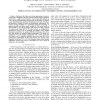Free Online Productivity Tools
i2Speak
i2Symbol
i2OCR
iTex2Img
iWeb2Print
iWeb2Shot
i2Type
iPdf2Split
iPdf2Merge
i2Bopomofo
i2Arabic
i2Style
i2Image
i2PDF
iLatex2Rtf
Sci2ools
103
click to vote
ICCAD
2007
IEEE
2007
IEEE
Exploiting STI stress for performance
— Starting at the 65nm node, stress engineering to improve performance of transistors has been a major industry focus. An intrinsic stress source – shallow trench isolation – has not been fully utilized up to now for circuit performance improvement. In this paper, we present a new methodology that combines detailed placement and active-layer fill insertion to exploit STI stress for performance improvement. We perform process simulation of a production 65nm STI technology to generate mobility and delay impact models for STI stress. Based on these models, we are able to perform STI stress-aware delay analysis of critical paths using SPICE. We then present our timing-driven optimization of STI stress in standard cell designs, using detailed placement perturbation to optimize PMOS performance and activelayer fill insertion to optimize NMOS performance. We assess our optimization on small designs implemented with a 65nm production cell library and a standard synthesis, place and rou...
Related Content
| Added | 16 Mar 2010 |
| Updated | 16 Mar 2010 |
| Type | Conference |
| Year | 2007 |
| Where | ICCAD |
| Authors | Andrew B. Kahng, Puneet Sharma, Rasit Onur Topaloglu |
Comments (0)

